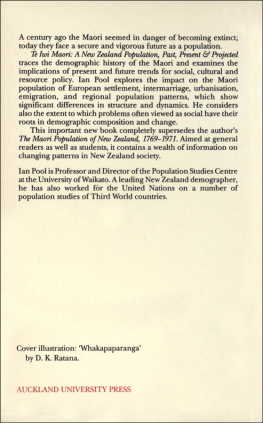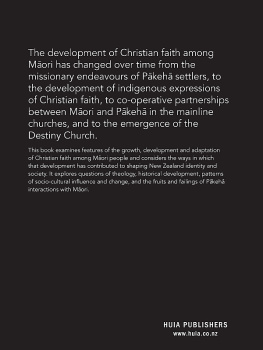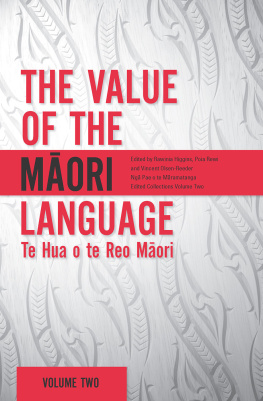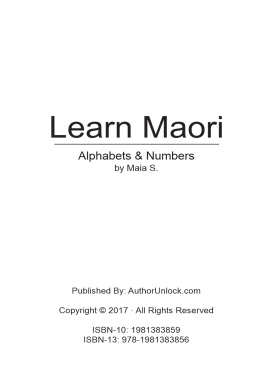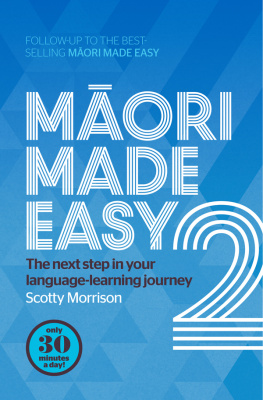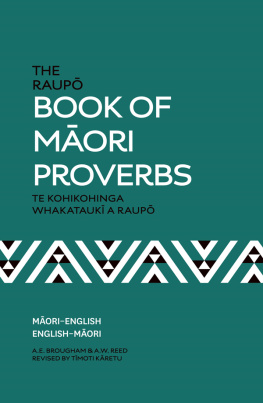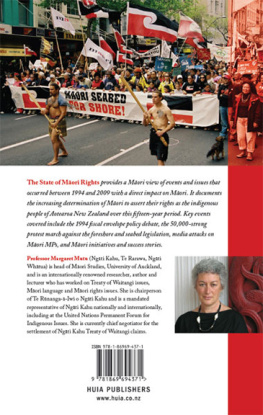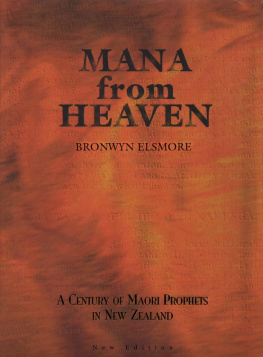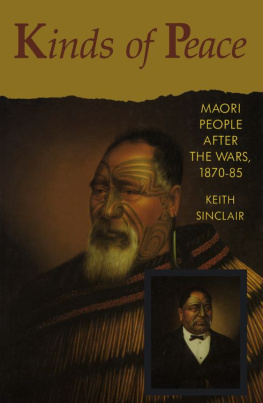Ian Pool - Te Iwi Maori
Here you can read online Ian Pool - Te Iwi Maori full text of the book (entire story) in english for free. Download pdf and epub, get meaning, cover and reviews about this ebook. year: 1991, publisher: Auckland University Press, genre: Politics. Description of the work, (preface) as well as reviews are available. Best literature library LitArk.com created for fans of good reading and offers a wide selection of genres:
Romance novel
Science fiction
Adventure
Detective
Science
History
Home and family
Prose
Art
Politics
Computer
Non-fiction
Religion
Business
Children
Humor
Choose a favorite category and find really read worthwhile books. Enjoy immersion in the world of imagination, feel the emotions of the characters or learn something new for yourself, make an fascinating discovery.
Te Iwi Maori: summary, description and annotation
We offer to read an annotation, description, summary or preface (depends on what the author of the book "Te Iwi Maori" wrote himself). If you haven't found the necessary information about the book — write in the comments, we will try to find it.
Te Iwi Maori — read online for free the complete book (whole text) full work
Below is the text of the book, divided by pages. System saving the place of the last page read, allows you to conveniently read the book "Te Iwi Maori" online for free, without having to search again every time where you left off. Put a bookmark, and you can go to the page where you finished reading at any time.
Font size:
Interval:
Bookmark:
TE IWI MAORI
A New Zealand Population Past, Present & Projected
Ian Pool

First published 1991
This ebook edition 2013
Auckland University Press
University of Auckland
Private Bag 92019
Auckland 1142
New Zealand
www.press.auckland.ac.nz
Ian Pool 1991
This book is copyright. Apart from fair dealing for the purpose of private study, research, criticism, or review, as permitted under the Copyright Act, no part may be reproduced by any process without the prior permission of Auckland University Press.
eISBN 978 1 86940 689 9
Publication assisted by the Historical Branch of the Department of Internal Affairs.
Distributed outside New Zealand by Oxford University Press.
When Auckland University Press first approached me to determine whether I would rework my earlier book, The Maori Population of New Zealand, 17691971 (1977), I saw the task as one of simply summarising and popularising what had been a rather technical analysis. Once I started, however, it quickly became clear that the undertaking would be very different, involving the writing of a completely new book. This is because the context of Maori demographic research had changed significantly in the interim:
There was by then a much larger body of research available on a number of questions. This was true, in particular, for the adjunct areas of prehistory and history, and in terms of the demographic analysis of contemporary and projected Maori patterns and trends of population change.
The decline of Maori fertility in the 1970s had been spectacular, yet this event had received surprisingly little recognition outside specialist circles. The velocity of the Maori reproductive revolution was a point I myself appreciated only when I started to look at analyses of the rapid Thai fertility decreases.
The knowledge base of demography itself had undergone quantum changes, in terms of its methodology, substantive issues, and its theoretical frameworks, all leading to a reassessment of the role and significance of various issues. It meant that researchers now had available to them much sharper tools, plus a better baseline of cross-comparative studies.
I had by then returned to New Zealand and had gained a different perspective on Maori population issues in relation to national social, political and developmental questions. The preparation of a short submission to the Waitangi Tribunal on behalf of the Crown Law Office in the Ngai Tahu claim, in which historical demographic events suddenly had very applied contemporary importance, had heightened this appreciation.
At the same time, I was able to continue my long-term research interest in the field of population and development planning, particularly with reference to Africa. This permitted me to place New Zealand demography in a broader cross-national perspective.
From the outset I was concerned about the fact that I was a Pakeha writing on Maori population change. I see my role primarily as exploiting my technical training in order to provide as rigorous an account as possible of Maori demographic trends. Obviously, however, this requires resort to cultural as well as social, economic, and other explanatory frameworks, but I regard my analyses as hypotheses rather than definitive conclusions. I leave secondary socio-cultural and historical analyses of the data presented here to those who have the skills for this task, the experts in Maori studies, history and archaeology, to name three examples.
Beyond this, I felt very strongly, and Auckland University Press concurred completely with me, that in a bicultural society such a caveat is insufficient; it is also imperative to ensure that a manuscript does not contain culturally offensive material. I am therefore particularly appreciative of the review Assoc. Prof. Ranginui Walker, of Auckland Universitys Department of Maori Studies, made of the entire manuscript. Dr Walkers contribution was very important, as he brought to this task exactly the correct balance, the rigour of a social scientist along with a wealth of experience as a public commentator on race relations.
When I came to prepare the book I was also acutely aware of another problem. Demography, the academic discipline I was applying to Maori issues, is a quantitative scientific field, dealing with complex interrelations between population trends and socio-economic change. As is true in other technical domains, some concepts and analyses are not well understood outside the discipline. Thus, when population analyses are competently and rigorously carried out, they risk being inaccessible to the general reader, to use a popular critical phrase. In the case of demography this problem is more acute because everyone lives the subject, as it were, and in some senses is thus an expert. The plethora of popular, often simplistic, but appealing analyses create difficulties for the researcher who must measure exactly, qualify, complicate, or contradict seemingly straightforward demographies. For example, this is an ongoing problem for those New Zealand demographers who deal professionally with migration. In that case, as for Maori population issues, demography becomes political arithmetick, to cite its seventeenth-century appellation. As a result, the analyst must attempt to be as precise and scientific as possible, yet must also struggle to make his/her material accessible.
In attempting to achieve this, I was particularly fortunate in that I was dealing with an editor who was competent professionally, yet combined this with an appreciation of the problems I was facing. I found that I could use Ms Elizabeth Caffins judgement to help me pitch my writing at a level which would be accessible to an intelligent lay reader, yet would not compromise demographic rigour. This was particularly true for those sections in which develop a theoretical framework essential for a re-evaluation of historical trends. Ms Caffins editing stance was always consultative and supportive rather than prescriptive.
I was also fortunate that a colleague from the Institut National dEtudes Demographiques in Paris, Dr Jean-Louis Rallu, had just completed an analogous historical study on Pacific populations. He kindly agreed to carry out a technical review of my prehistorical and historical chapters. I am particularly grateful to him, as these sections of the book involved the custom-designing of new models drawing on demographic theory. He also gave me permission to quote personal communications.
The more contemporary material and the projections came from two sources. They were either drawn from articles I had authored or co-authored, and which had been subject to peer review, or were synthesised from other technical studies, to which I make reference, and which have also been subject to professional critiques.
Of course, as will become obvious, I also stray into other domains, notably prehistory and history. Here I submitted chapters to editorial review, to insure that they met the standards of those other disciplines. Dr Janet Davidson of the National Museum, an authority on New Zealand prehistory, read and criticised . Dr Davidson also allowed me to cite personal communications. I acknowledge not only my technical debt to these two scholars, but also their professionalism and efficiency. I also benefited from a long and very interesting meeting with Dr Doug Sutton of the Prehistory division of Auckland Universitys Anthropology Department. The research staff of the former Department and now Ministry of Maori Affairs, particularly Dr Graeme Butter-worth and Mr Cyril Mako, assisted me with publications and comments, especially on issues of definition.
Next pageFont size:
Interval:
Bookmark:
Similar books «Te Iwi Maori»
Look at similar books to Te Iwi Maori. We have selected literature similar in name and meaning in the hope of providing readers with more options to find new, interesting, not yet read works.
Discussion, reviews of the book Te Iwi Maori and just readers' own opinions. Leave your comments, write what you think about the work, its meaning or the main characters. Specify what exactly you liked and what you didn't like, and why you think so.

